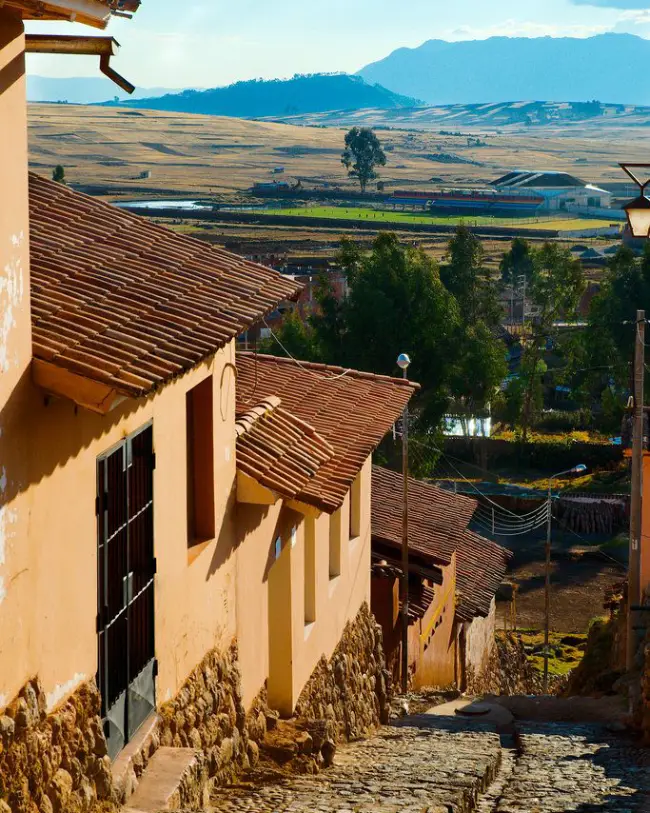Before Machu Picchu overwhelms you with its grandeur, before the high mountains wrap you in their mysticism, there’s a place where Inca history feels closer, more alive, than anywhere else: Chinchero Cusco.
Visiting Chinchero means walking through the hues of ancestral textiles, between centuries‑old agricultural terraces and cobblestone streets. Exploring this village before Machu Picchu is more than a travel choice; it’s preparation, because only those who have touched history with their own hands can view the marvels of the Andes with fresh eyes.
What does the scent of damp earth evoke? In this article we share five reasons to visit the Rainbow Town.

Where the walls still speak. Source: Machu Picchu Viajes Perú.
Reason #1: The history that refused to die
What does it mean to walk a town that once burned to survive?
Chroniclers say that when the conquistadors advanced with an appetite for domination, Manco Inca, last bastion of resistance, set Chinchero Cusco ablaze so the Spaniards would find nothing but ashes. It was not defeat but strategy: a controlled fire that bought time to flee toward Vilcabamba’s fortress.
Neither charred stones nor ruined homes erased Chinchero. Its archaeological ruins, silent witnesses to struggle, blend with the colonial church the Spaniards built atop Inca temples, a layering of eras shouting its own story.
Those who set foot in Chinchero before Machu Picchu discover not only beauty but sacrifice. Understanding the Incas’ fight lets you admire their masterpiece with true reverence.

Culture carved in stone and cloth. Source: Pinterest.

The fragility of handmade art. Source: Adobe Express.
Reason #2: Spinning the past

Blooming beneath a roof. Source: Adobe Express.
Sitting in a weaving workshop while visiting Chinchero is a live lesson in Inca memory. The weavers, wrapped in colorful llicllas, welcome travelers with warm smiles, patiently explaining the Chinchero textile‑making process, knowledge passed from mother to daughter for generations.
First comes washing with saqta root, a plant that perfumes the wool and leaves it as clean as the snow‑capped peaks guarding the valley. Then the magic of dyeing: cochineal for the earth’s deep red, qolle for the sun’s yellow, and indigo for the sky’s rich blue. Everything is natural, an offering to Pachamama.
The looms are more than tools; they are codices narrating Andean worldview. Designs are never random: each figure is a symbol, stories of battles, harvests, and life itself. In every sash, blanket, and poncho, there’s a distinct sweetness, the pride of keeping a tradition alive.

Life that knows how to sustain itself. Source: Clva.

Resistance woven gently. Source: Aguayo.
Reason #3: Community through the market
Sundays in Chinchero smell of damp earth mixed with fresh herbs. It’s market day, and the village square turns into a vibrant tapestry of color and sound.
Calloused hands weigh potatoes of countless shapes and hues, corn shines in almost impossible diversity, and craftswomen lay out mantas woven with patience and mastery. There are no middlemen, just honest bartering, the way trade happened long before money reached these lands.
Visiting the Chinchero Sunday market is stepping into a scene little changed over centuries.

The art of knowing oneself everlasting. Source: Overblog.
Reason #4: Architecture and identity
In Chinchero, history isn’t erased, it’s layered. Built in the 17th century atop an Inca palace, the Church of Nuestra Señora de Monserrat reflects a clash of worlds: wooden ceilings with Mudéjar details, Baroque frescoes telling biblical stories, and beneath it all the steadfast Andean stone, immovable, eternal.
Inside, colors and devotion abound. Each brushstroke on its murals shows Andean identity disguised in Christian iconography: angels wearing embroidered tunics, Virgins with Mestizo faces, saints who watch with the gaze of ancient amautas. It’s a space of faith and cultural resistance.
Visiting Chinchero lets you see how colonial architecture never erased the Inca past; it settled upon it, fusing stories you can feel only here.

Sunset making peace with the cross. Source: Iglesia del Pilar.

Rooftops tilted toward the sun. Source: Flickr.
Reason #5: Natural landscapes
How to get there?
From Cusco, visiting Chinchero Cusco takes just 45 minutes by car or bus. Only 30 km/18 mi away, the ride offers sweeping views, from Andean hills and farmland to the village of Chinchero on the horizon.
- Public transport: Frequent buses and colectivos leave from Avenida Grau in Cusco; simply tell the driver you’re heading to Chinchero and you’ll arrive in under an hour.
- Organized tour: Many agencies offer circuits that include Chinchero district within the Sacred Valley, pairing it with sites like Moray and the Maras Salt Pans.
- Private car: Prefer exploring freely? Rent a vehicle and travel at your own pace. The road is well paved and clearly signed.
Best time to visit Chinchero
Chinchero Peru charms in any season, but the optimal window is April to October, the dry season. Clear skies and bright sun highlight the surrounding peaks and make market days a delight.
For the most authentic cultural vibe, Sundays are ideal thanks to the bustling chinchero market, where local communities gather to trade goods.
If you prefer a quieter atmosphere to explore the ruins and colonial church, any other day of the week lets you enjoy the site in calmer conditions.

The sky weeps gold. Source: Benjamin Dumas.
What to pack?
Although Chinchero sits only a few kilometers from Cusco, its elevation of 3,762 m (12,000 ft) means weather shifts throughout the day. To make the most of your visit:
- Layered clothing: Mornings can be chilly, yet the Andean sun is intense at midday. Pack a light jacket or windbreaker.
- Sun protection: Hat, sunglasses, and sunscreen are essential, even on cloudy days.
- Comfortable shoes: Cobblestones and red‑dirt paths call for sturdy footwear.
- Cash: Many market stalls and weaving cooperatives don’t accept cards.
- Water and snacks: The altitude can make walking more demanding, stay hydrated.
- Camera or phone: Every corner of Chinchero deserves a photo.
So, why visit Chinchero?
Because it’s like an inhabitable rainbow. There’s no need to filter out city noise or fight crowds. In Chinchero, Inca heritage intertwines with daily village life, from hands spinning wool with natural dyes to Quechua echoing in every corner. It’s Cusco in its purest state, without adornment or artifice.
At Inkayni Peru Tours, we believe visiting Chinchero before Cusco isn’t about itinerary but perspective: starting your journey with a closer, more genuine experience, feeling culture in its most authentic form.

Stones know that embraced, they support centuries. Source: Flickr.

Color isn’t sold, it’s inherited. Source: Allana.
Frequently Asked Questions
Can you visit Chinchero in a single day from Cusco?
Yes. Chinchero is only 45 minutes from Cusco (about 30 km/18 mi), a short journey where landscapes shift dramatically, revealing snow‑capped peaks as you leave the city. Arriving in Chinchero gives meaning to every detail.
Within a day you can roam the archaeological site, marvel at the colonial church’s centuries‑old frescoes, browse the artisan market, and watch live Andean weaving. Start early to enjoy golden morning light on the ruins and ample time to immerse in local culture.
Are guided tours available in Chinchero?
Absolutely. Departing from Cusco, guides lead you through Inca terraces, the colonial church, and the storyline of resistance, highlighting the Qhapaq Ñan (Great Inca Road) and the symbolism woven into local textiles.
There are tours focusing solely on Chinchero or combined circuits with other Sacred Valley spots such as Maras and Moray. Private and group options exist, some include weaving demonstrations and tastings of Andean products.
When is the best day to visit the Chinchero market?
The market runs daily, but Sundays are special. That’s when residents from nearby communities arrive with their textiles, native potatoes, medicinal herbs, and fresh produce. Unlike more tourist‑centric markets, trueque (barter) is still practiced here, a living vestige of ancestral Andean economy.
For authenticity and a glimpse of locals in their trading routine, Sunday is ideal. For quieter browsing of textiles, any weekday works well.
Do you need a ticket to enter the archaeological site?
Yes. Access requires the Cusco Tourist Ticket, which also covers other Sacred Valley sites like Ollantaytambo, Pisac, and Moray. You have two options:
- Partial Ticket: If your plan centers on Chinchero and nearby Sacred Valley sites.
- General Ticket: Includes museums and additional ruins in Cusco.
Tickets are sold in Cusco and at site entrances. Bring cash, cards aren’t always accepted.
What is Chinchero’s altitude?
Chinchero Cusco sits at 3,762 m (12,000 ft), higher than Cusco (3,399 m/11,100 ft) and Machu Picchu (2,430 m/7,900 ft). It’s perfect for acclimatization before high‑altitude treks like the Inca Trail or Rainbow Mountain.
Mornings and nights can be cold, so pack warm layers, sunscreen, and hydrate well. If you’ve just arrived in Cusco, walk slowly and try coca tea, an age‑old infusion that eases altitude adaptation.







